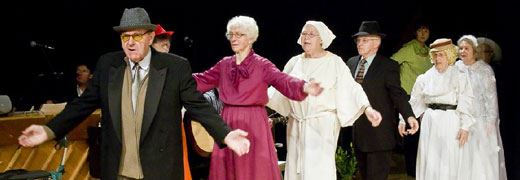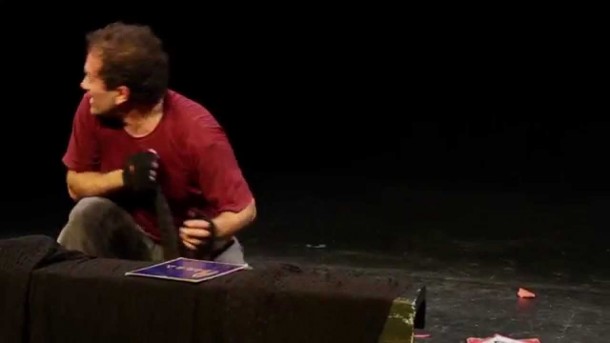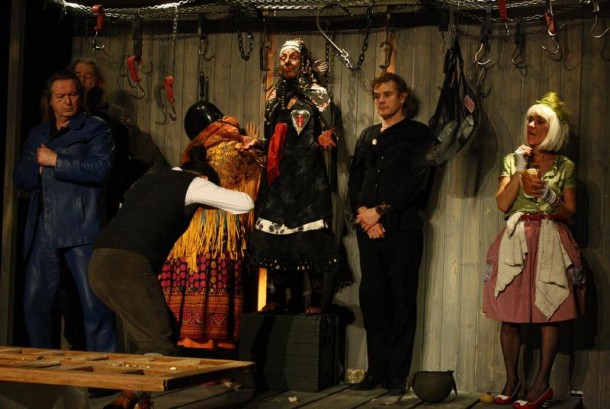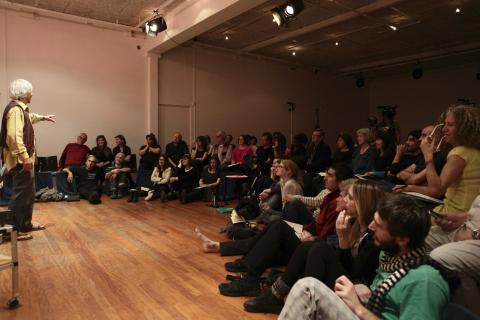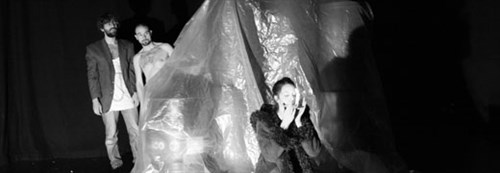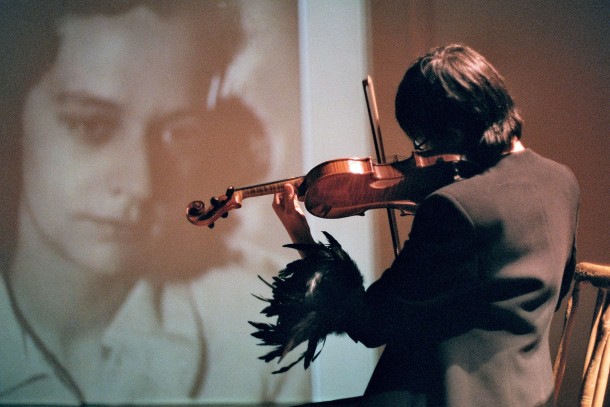From May 15 to 19, 2014, the symposium, “Theatre as a Laboratory for Community Interaction” convened in Holstebro, Denmark at Eugenio Barba’s Odin Teatret (founded in 1964 in Oslo, Norway) by the theatre’s concomitant research and publishing wing, Nordisk Teaterlaboratorium. In the spirit of Barba’s 50-year-old experimental laboratory theatre, with its roots in the Theatre Laboratorium work of Jerzy Grotowski, the symposium posed challenging questions for experimental theatre practitioners still known for rarefied creation behind closed doors usually open only to small audiences, often an invited public. The invited presentations by scholars and practitioners all interrogated how the Grotowski-Barba legacy functions in outdoor or in-situ performances. However, while the symposium presentations focused on the productive shift from indoor to outdoor, box office to barter, and passive reception to activism, the six powerful theatre works included in the symposium were all in-door studio performances, therefore neither outdoor, nor barter, and only marginally activist. These six performances were somewhat at odds with the spirit of the symposium because the methodological friction arising from the movement from laboratory studio toward outdoor/in-situ performances was not comprehensively addressed. Thus, though the symposium could have provided a unique opportunity to initiate a truly clinical discussion around its central theme, community interaction, ultimately these disparities problematized the theatre works’ inclusion in a symposium devoted for the most part to the advent of community-focused outdoor performance.
What distinguished Odin’s guest speakers at the symposium was that they renounce theatre edifices large and small; they prefer to do theatre in the streets than even within an intimate theatre studio. And the dramaturgical tension between street theatre and studio theatre has been at the core of what has made Barba important over the years because, although he did his initial work indoors (begun in 1964) in studios and continues to do so today, in 1974 he brought Odin out into the streets of Carpignano, a tiny Italian village, to expose a true public, the citizens in the village square, to that which at one time was reserved for an indoor elite. He named this kind of performance “barter,” and audiences were expected to compensate the Odin for their performance not with cash but with performances from their own traditions of song, dance, or of other kinds of performance/rituals depending on the local customs. Barba continued this practice not only in southern Italy, but Argentina, Brazil, Chile, Colombia, Peru, and Uruguay throughout the late 1970s and 1980s, and even now virtually wherever he goes Barba organizes outdoor community events, most notably Holstebro’s yearly Festuge, in which local institutions and organizations collaborate with the Odin to create outdoor theatre events. In his on-going practice of theatre as barter, Barba became admired both by a public who prefers theatre in the street, and, most important, many leftist theatre practitioners who started theatres of their own so they could practice theatre as barter as well as other genres of street performances that eschewed not only the sanctified edifices of mainstream theatre but equally the often stuffy environment of the small room. In many ways these theatres’ dramaturgies differ from that of Barba. Though they stem from his impulses to get out of the house as it were, Barba has always returned to his safe European home in Denmark, whereas his contemporaries, especially in Latin America, such as Miguel Rubio, director of the Yuyachkani Theatre Collective in Peru, were never so fortunate to have the kind of muscular financial infrastructure that Odin Teatret has enjoyed. In 2014 Odin Teatret received 48% of its income from various Danish subsidies, mostly from the town of Holstebro. The theatre itself earned 52% (more than one million euros) with its own performances and other activities. The budget of Odin Teatret is more than two million euros yearly. The paradox is that Barba’s work, although founded on principles established indoors in laboratory theatre studios, without announcing any political motivation when it moved outdoors (though celebrating local culture is deeply political), became seminal for the performance structure deployed by many left wing theatre practitioners as part of concrete and explicit political agendas both in the streets and in non-theatrical communities of interest such as hospitals in Italy and Roma encampments in Spain (two examples of work presented in talks by symposium participants). And this paradox colored but did not adequately contextualize the reception of the symposium’s six performances. The six performances were all indoor studio performances despite the wonderful Jutland May weather.
There were two daytime performances, nestled in between symposium talks. The first was The Song of My Life performed in the Black Room (The Black Room is a small indoor studio work space that has been used for training and performances by the Odin since establishing itself in Holstebro since 1966, where there is also a White Room, a Red Room, and a Blue Room) by Humøgruppen (the Group of Good Humor), created and directed by Odin actor Kai Bredholt (Denmark), who joined the Odin in the 1990s primarily as a musician only to become a highly skilled actor and director. The group consists of elderly people ranging in age from 68 to 94 who are members of a Holstebro activities center. Bredholt constructed The Song of My Life over a period of seven years. The performance portrays the performers’ cultural life (picnics, parties, dates, and birthdays). The Song of My Life, full of music (both newly composed and traditional) and dance, is fraught with interpersonal intimacy including expressions of dismay at childish teasing, jealousy over lost love, and joy of sexual conquest. Based on the performers’ own stories, in his introduction to the work, Bredholt claimed that part of the work’s purpose was to allow the performers to recollect bodily and kinesthetic memories from the dance floor to the hospital bed through the re-enactment of activities they have done for a lifetime, thus they embody their younger selves. Though this may seem somewhat nostalgic, it is also heroic since the cast of thirteen includes five severely disabled actors. In general all challenge themselves to move as adroitly as people half their age. The singing was full voiced and the accordion, guitar, African drums (carried in the baskets of the battery-operated walkers), and piano playing were superb. The performers’ stories were interwoven in a style reminiscent of the pastiches seen in Barba’s own large scale productions, overlapping and seeping one into another with transitions reliant on multivalent visual imagery and alternate uses of the space. For example, in one particular segment perhaps the oldest woman in the troupe celebrates a birthday, singing while simultaneously knocking back ten glasses of brandy, while two other performers hold a red fabric taut in front of her as a table upon which she sets her brandy glass, which is trampolined into the air, whereupon catching it she drinks again five more times. And then the cloth is switched from its red side to its yellow side. The actors cover her, tucking the protesting drunkard into bed as she continues to sing with the group. The red fabric is then spread on the floor; while one woman mimes planting seeds, the red fabric becomes a garden. On the right and left of the fabric two men stoop over, and while another woman pours water onto their backs, they begin to grow tall like plants. Then, after a blind woman is escorted through the garden, the red fabric is removed and the entire company begins to dance to the well-known American melody “She’ll be Coming Around the Mountain When She Comes.”
The Humøgruppen’s actors’ performed recollections of bodily and kinesthetic memories, their portrait of the joy of life, and its companion, fear of death. The Song of My Life’s assertion of the strength and cogency of the human spirit has an inherently Nordic impact similar to the faith Ibsen placed the human spirit’s durability, surreptitiously inscribed in the symbolic action that characterizes his final drama, When We Dead Awaken. For example, another story is told through patchwork scenes: A mother and father send their son off to war. After being wounded his telegrams home are intercepted by a woman, who grabs them from the hands of the courier and throws them into the audience. The interceptor then delivers a red letter to the parents, which is understood to be a death notice. So the family believes their superficially wounded son to be a fatality of war. The parents’ weeping is underscored by light-hearted singing, and suddenly their son returns home. Vexed with their son for scaring them, the parents send him directly back to war where he then gets killed. The mother places a red flower on his corpse and there he lies, until the next scene begins with women out fishing. They reel the actor in, yet now he is transformed from dead soldier to hooked fish. This is followed by a scene of a child’s death, and the dead child’s ascension into heaven is accompanied by a winged angel who takes the child out rowing and then marries her. After a honeymoon coach ride, they dance and sing “Auld Lang Syne” in Danish and The Song of My Life comes to an end.
The Humøgruppen performers’ honest and bold acting style—the intimate gestures and narratives through which they expose their bodies, their voices, their memories—makes The Song of My Life an exceptionally moving and powerful performance. The actors’ attention to detail and deliberate belief in the logic of the dramaturgy of memories interspersed with analogical non-linear narrative action allows the audience to mobilize its own memories too, thus elevating the quotidian to an experience of elation, appropriate for a theatre called the Group of Good Humor.
The second daytime performance was Nightwind, given by Hector Aristizábal (an activist theatre artist and psychologist from Medellín, Colombia now living in both the United States and Colombia and directing ImaginAction Theater, using theatre and post-performance audience dialogue to address to struggles of torture and trauma survivors). Aristizábal performed his monodrama with minimal multi-purpose bargain shop props and costumes to tell the story of his and his Marxist brother’s persecution, abduction, and torture by Colombia’s American-backed anti-communist death squads and Aristizábal and his mother’s reactions to the brother’s ultimate execution. Aristizábal, playing all the roles, smoothly shifting between himself, his brother, mother, and the mercenaries, has constructed a text consisting of rapid fire accusations and death threats during interrogations interspersed with snippets of letters between Aristizábal and his mother after he made his escape from Colombia to the USA. Aristizábal’s performance style is reminiscent of broad mime and sparse use of language (a genre of modern Commedia dell’arte once practiced by Jean Louis Barrault). All characterizations take extreme physical form bordering on the grotesque, especially scenes of torture, of vigilantes fleeing in jeeps, and the weeping mother at prayer. Most of the action was performed on the back of a chair, and the costume was a recycled black cloak serving as the various costumes of all the characters. What made this performance exceptional was the use of comico-farcical devices in a story of terror and torture. And though the Odin also uses the physical techniques of Commedia dell’arte in contemporary performance situations, it is more accurate to say that Aristizábal’s dramaturgy emerges from Boal/Freire practice rather than the Barba tradition. Since a key factor in Augusto Boal’s Theatre of the Oppressed methodology is post-performance dialogue between performers and their audience, whereas there is rarely any dialogue between Barba’s audiences and his actors after their performances, Aristizábal represents a markedly distinct political theatre tradition. Yet in Aristizábal’s discussion after Nightwind he stated that it was Barba who had the most influence over him during the last forty years (even though there was no dramaturgical evidence of this claim) and that it was an honor to perform at the Odin now in light of Barba’s long career as an activist theatre artist. Aristizábal’s approach calls to question why some practitioners deem it necessary to have post-performance talks with audiences and whether they matter. In this respect Aristizábal represents many of those artists present at the symposium who did not perform but rather presented video excerpts and descriptions of their work, whose political, community-based outdoor theatre departs from Barba’s theatre ideal. In Central and Latin America, activist groups and collectives like ImaginAction Theater and Grupo Cultural Yuyachkani’ utilize performances to address social trauma by initiating conversations on the violent actions the repressive states subjected their people to during the 1960s, 1970s, and 1980s, in particular coups, dictatorships, guerilla-movements, and disappearances. In this sense, Barba’s peaceful and privileged Danish work environment differs significantly from conditions under which artists like Aristizábal work, thus engendering starkly distinct thematic concerns.
The symposium also included four evening performances. On the first night was Barba’s own The Chronic Life, a complex one-hour piece danced more than acted on a runway stage situated in a cargo container storage unit outside Holstebro. In brief, The Chronic Life occurs in what its program describes as a fictional 2031 “post third Civil War” European dystopia. Through broad physical action, poetic texts, song, and music are performed in multiple languages. The opus addresses the trauma of women widowed and children orphaned by the recent war. The character descriptions alone tell a story. A black Madonna more Celtic than Catholic played by Iben Rasmussen is veiled in layers of black lace with three small protruding wooden hands, one from behind her head and two others from the left and right behind her ears where one might expect the feathers of a Native American, her face generally frozen in the kind of mask seen on actors’ faces in Grotowski’s Akropolis. A singing character, the widow of a Basque terrorist, played by Kai Bredholt, with a string of pearls around his neck, dressed in mourning, clutches a small handbag from which she pulls an enormous revolver and hands it to a child. A Chechen widow/refugee, Nikita (perhaps the most fascinating character), played by Julia Varley bedecked in multi-colored shawls wanders with her dead husband’s uniform packed in her travel kit along with a deck of playing cards with which she tells the past. She scatters the cards like butterflies across the space. “You are the only country I want to belong to,” she recites her dead husband’s words to herself. A self-destructive, obsessively clean, Romanian housewife played by Roberta Carreri, dressed in 1960s fashionable green-checkered blouse and candy-striped pink and white skirt wearing a platinum blond wig, more than once attempts suicide by stuffing her mouth with bread and pulling a plastic bag over her head, taping it tightly closed only to remove it in panic and spit out the bread at the onset of suffocation—a domestic Houdini. A Faroese rock musician played by Jan Ferslev, whose long wolfish gray hair, studded embroidered blue denim jacket and leather pants and constant companion the electric guitar ultimately affirms that rock though maybe not dead is nonetheless grizzled. A Danish attorney played by Tage Larsen in a robin’s-egg blue leather two piece suit, reads from a blank book of law from which he constantly pulls out coins to toss at the other players which references an earlier Odin production, Min Fars Hus (My Father’s House) (1972-74), where coins rain across the stage in a torrent of jingling change. Sofía Monsalve Colombian boy searching in vain in Europe for his dead father. After being blinded early in the performance, the boy wears gauze patches over his eyes, and in some instances is paired with a look-alike puppet of another boy also looking for his dead father. It is the Colombian boy’s search for his dead father that holds the performance together as a story. And two mercenaries, played by Donald Kitt and Fausto Pro (the performance’s technicians), dressed in para-military garb, function as stage hands who also duly torture the Colombian boy via electric cables connected to a portable generator. Aside from the mercenaries, all the characters play musical instruments. Over the course of the performance, the Colombian boy becomes blind, while the black Madonna cuts out her own tongue. Blindness and silence as a recurrent doubled theme reaches apogee when, at the end of the performance, after each character’s story touches and imbricates itself with all the others, the mercenaries confiscate the older characters’ musical instruments, and at this moment the Colombian boy regains his eyesight. He is also given a revolver by the Basque widow. Stepping off the runway, thus leaving the European dystopia, he meets a similarly-attired blind boy, a wandering violinist in search of his father. Striking up an instant friendship, the newly-sighted Colombian boy exits the theatrical space laughing with his revolver pointed at the head of his new doppelganger friend.
The performance appears constructed as an intricate web of highly stylized, culturally specific references to practices of widowhood throughout Europe which overlap with metatheatrical references to Meyerhold and Grotowski mises-en-scene. One such theatrical reference is the tableau near the end, just after the characters have been forced to turn their instruments over to the authorities. This montage, it is believed by Danish dramaturg, Annelis Kuhlmann, pays homage to the Russian director, Vsevolod Meyerhold, since it so sharply resembles the final silent tableau of his famous 1926 production of Gogol’s Government Inspector. Another metatheatrical gesture is Rasmussen’s acting, which at moments resembles Ryszard Cieślak in the flagellation scenes from Grotowski’s 1966 The Constant Prince. Barba also incorporates a number of self-referential images, for example when Rasmussen’s bloody Black Madonna dons the same white wings she wore in Talabot (1988-90) as the playful Trickster, described then in the program as “a strange elf with wings and a feline face.” All of these contemporary archetypes crash through the space singing along with rhythmic footsteps, accompanied by the sound of coins raining on the runway’s wooden planks. At The Chronic Life’s climax the adult characters break through a wooden table-top under which a Plexiglas coffin contains the mummified puppet cadaver of the blind Colombian boy’s father. The child crawls into this coffin and is entombed with his dead father and later escapes.
One can read this performance through many lenses. I prefer to see it as Barba’s Europe; Kuhlmann sees it as Barba’s view of the world of theatre through theatre itself. And there are other possible interpretations: The Chronic Life can be understood as a journey through the future—a journey through Barba’s imagination of deeply inscribed visual imagery accumulated over a 50+ year career. According to the program, the performance is “Dedicated to Anna Politkovskaya and Natalia Estemirova Russian writers and human right activists, murdered by anonymous thugs in 2006 and 2009 for their opposition to the Chechen conflict.” Perhaps in a gruesome way, The Chronic Life demonstrates how Barba possesses an optimism that the youngest generations of today will learn to accept and assimilate the violence inherent in twenty-first century Century global war. In a June 2013 interview in Freiburg, Germany, Barba said:
“When I discuss The Chronic Life many people say it is very depressing the way you express what is happening to children, but I do not feel it is depressing. It was not intentional. In a way I am feeling it was an optimistic performance. Each generation finds its own solutions. All throughout history it happens, sometimes in a terrifying way, like for instance in the 30s in Europe with Nazis and fascists. This is a very depressing time. In Europe today it’s so desperate because there is no work. But I also say that there is a smiling indication that all the beliefs, when they are taken to a certain extent, they become the opposite. So socialism becomes what it is. Fundamentalism ruins any religion – the opposite of belief – thus it is opposed to respect for individual dignity. But somehow children always emerge.” (Freiburg June 14, 2013)
Depressing or not, The Chronic Life is rich in interpretive possibilities. For example, Magdalena Hasiuk writes in “Constellation of Somnambulists” that the performance is about “a place where the gods are still hungry for human blood. […] This diagnosis of Europe is quite alarming” (1). In “Odin’s Blind Eye – More than Your Eyes Only: (The Chronic Life) Odin Teatret in a Disappearing Act of Blindness,” Kuhlmann, says: “stories of loss paradoxically become stories of hope […] which especially applies to the women as if they were […] using love stories in order to survive” (60). If The Chronic Life is a portrait of Europe now and the Europe to come, and his metatheatrical impulse makes Barba Europe’s fortuneteller, then the tragic-comic tension between blood thirst and love story captures tensions within Europe both for those who embrace and those who renounce European whiteness, Christian idealism, Eastern orthodoxies, Islamic presence, Jewish heritage, ethnic self-determination, wave upon wave of immigration, social democracy, nationalism, anarchic impulses, and Marxism old and new. In The Chronic Life, Barba portrays a kind of romanticism that amplifies European heterogeneity through its mythic present via the characters’ embodiment of tragic loss mingled with hope—well reasoned or not—through the encounters of a displaced Colombian boy in search of a dead father. The Chronic Life is surely the most explicitly political of Barba’s productions to date.
At the opposite end of the aesthetic spectrum was the second evening performance, Pop Economix, created and performed by Italy’s Alberto Pagliarino, artistic director of Turin’s Caravan of Artists on the Road. Pop Economix, a one-man comic monologue about an American who turns his home into a cash dispenser, posed disturbing questions about whether and how Europe benefited from the economic crash in the United States brought on by the activities and accumulation of massive wealth by Lehman Brothers’ chief executive director, Richard Fuld. Uncharacteristic of the other more experimental works seen at the symposium, Pop Economix functioned more as a satirical comedy revue in which Pagliarino portrayed a professor of economics whose profanations and pie charts lampooned Europeans’ irrational tendency to blame their economic woes on the USA home mortgage crisis that had, through Fuld’s misdeeds, empowered America’s very rich and filled the pockets of its upper class and millionaires somehow at the expense of Europe—quite in tune with (and derisive of) the leftist/social activist penchant and ideology of most of the visiting international theatre artists and scholars the majority of whom came from EU and South America.
The third evening performance was Tomorrow by four of the Jasonites, a larger group of resident theatre artists from twenty-three nations at Odin Teatret to take part in the performance The Marriage of Medea. Tomorrow was performed by Isadora Pei (Italy), Marcelo Miguel (Brazil), Alberto Martinez Guinaldo (Spain), and Markus Karekallas (Finland) and was directed by Julia Varley (Great Britain, who joined the Odin in 1976). Like The Chronic Life, Tomorrow takes spectators back to the future. Tomorrow is a virtually (perhaps purposely) unintelligible ritualized vision of an apocalyptic world underground where three sweat-drenched performers, sometimes wearing the helmets of coal miners, communicate through guttural speech, banging on giant oil barrels, and sexualized violent dance on a stage draped with thick plastic painters’ tarps, while fascist slogans (in particular quotations from Adolph Hitler in English) spewing from a shaky hand-held projector controlled by the on-stage lighting tech are emblazoned at an uncomfortable angle on an upstage screen. At points, raw meat is strewn across the playing space. The program reads:
Tomorrow instead of birds, dogs will wake us” an actress, like Cassandra, foretells the future. No one believes her. All theatres have burnt. Live fire illuminates human faces. Feeble electric lights shine from heads packed into plastic. A stern young generation expresses its vitality and visions through purposeless clamour and actions, submitting itself to senseless tests of courage, battling each other, staggering in the darkness, falling into dreams, consoling each other. Walls collapse and water pours over the wounds. They are learning the language of snakes; they are gathering an army of ants. Tomorrow is already today.
Not for the faint of heart, Tomorrow is a gruesome twenty-first century grand guignol which merits a larger audience because socially conscious experimental theatre is the most intimate medium for confrontation with the kind of hunger for violence and thirst for survival the Jasonites and Varley have choreographed for today’s public.
The fourth performance was Ester’s Book, written and performed by Iben Rasmussen (Denmark, who joined the Odin in 1966). Ester’s Book was presented as the farewell performance after all the symposium events ended, right after the last communal supper. Ester’s Book refers to Rasmussen’s deceased mother, Ester’s diary. From this book, after writing each entry, Rasmussen, personifying Ester, tears out a page, rolls it like a cigarette, and then lights one end with the candle on her writing desk, snuffs out the candle as if to smoke before bed. In the darkness through music and projected images from the actual photo album of the real Ester, the performance makes the transition to the next day. Accompanied by a woman playing violin (who appears in the daytime segments with her back to the audience figuratively functioning as the daughter visiting her mother in the home for the elderly), Rasmussen commemorates her mother, Ester, whose recent death at 85 was the point of departure for a performance that calls into question how people in general accept and deny the struggles of dying parents. Each day Ester asks her daughter, “Do you think I can come and live with you in the caravan behind the theatre? I won’t be any trouble.” The daughter’s response, “We’ll see when spring comes,” affirms the malaise of grown children who when facing their parents’ deaths are also confronting their own mortality. Ester’s Book, directed by Rasmussen, is uncharacteristically sentimental. The inclusion of Ester’s photos from Denmark in the final days of World War II of her as the chain-smoking young bride to a famous author and new mother to a future actor are curious. Barba is not one to use a projected images in performance, generally preferring the human element to multi-media. Throughout the performance, Rasmussen, portraying her mother, sang the popular songs of post-War Denmark as she tore pages out of her diary to roll into cigarettes. As the rolled up pages lay smoldering in her ashtray, and Ester wondered aloud whether her daughter would soon take her away from the elder home to live in the caravan behind the theatre (which indeed was where the real Ester did spend her final days), Rasmussen’s performance functioned as much as medicine for the actor as it did for the spectators.
Barba, at 79, may now wonder too what is the future of his legacy, and this convocation of younger generations of Barba satellites who make excellent though strange theatre in equally strange settings (both indoors and out) may be a sign of what is to become of the Barba legacy in years to come as the theatre of Central and Northern Europe’s great experimental movement becomes a kind of global mobilization of theatre further away from the mainstream and ruling classes than ever before as a permanent force for social action.
Funding for this work was provided by the Office for the Advancement of Research at John Jay College.
, Chairperson of John Jay College of Criminal Justice’s Department of Communication and Theatre Arts is the author of “Theatre Ethics and the Performer’s Amoral Duties: an Axiology for the Actor” in Tension and Recognition. University of Wrocław Polish Philology Institute Department of Theory of Culture and Performing Arts (2014); “Ketmanship in Opole: Jerzy Grotowski and the Price of Free Expression” in The Drama Review Winter 2009; “Anarcho-Radical Roots—Opole to Oslo to Holstebro 1959-69; Eugenio Barba’s Early Experimental Theatre as Intervention” in Vectors of the Radical: Textual Exchange, Global Radicalism, and the 60s (2002) and “No Longer in Search of an Author, a Character Defines Herself; Pirandello’s Six Characters in Search of an Author Viewed within the Context of Eugenio Barba’s Experimental Performance Methodology.” Modern Drama (2002). In June 2015 Baumrin directed Sous poétique: Le sens—noyau in Paris, at Lilas en Scene. Baumrin has also directed over sixty theatre and opera productions, including Il Furioso (a Spanish/English production of Aeschylus’ Furies); Offenbach’s Tales of Hoffman, performed under the Brooklyn Bridge; Darius Milhaud’s Medée; Federico Garcia Lorca’s As Five Years Pass; Calderon de la Barca’s Life is a Dream for the Chamizal Festival in Juarez, Mexico; and Carson McCullers’s The Member of the Wedding.
European Stages, vol. 4, no. 1 (Spring 2015)
Editorial Board:
Marvin Carlson, Senior Editor, Founder
Krystyna Illakowicz, Co-Editor
Dominika Laster, Co-Editor
Editorial Staff:
Elizabeth Hickman, Managing Editor
Bhargav Rani, Editorial Assistant
Advisory Board:
Joshua Abrams
Christopher Balme
Maria Delgado
Allen Kuharsky
Jennifer Parker-Starbuck
Magda Romańska
Laurence Senelick
Daniele Vianello
Phyllis Zatlin
Table of Contents:
- Report from Berlin by Yvonne Shafer
- Performing Protest/Protesting Performance: Golgota Picnic in Warsaw by Chris Rzonca
- A Mad World My Masters at the Barbican by Marvin Carlson
- Grief, Family, Politics, but no Passion: Ivo van Hove’s Antigone by Erik Abbott
- Not Not I: Undoing Representation with Dead Centre’s Lippy by Daniel Sack
- In the Name of Our Peasants: History and Identity in Ukrainian and Polish Contemporary Theatre by Oksana Dudko
- Performances at a Symposium: “Theatre as a Laboratory for Community Interaction” at Odin Teatret, Holstebro, Denmark, May, 2014 by Seth Baumrin
- Songs of Lear by the Polish Song of the Goat Theatre by Lauren Dubowski
- Silence, Shakespeare and the Art of Taking Sides, Report from Barcelona by Maria M. Delgado
- Little Theatres and Small Casts: Madrid Stage in October 2014 by Phyllis Zatlin
- Gobrowicz’s and Ronconi’s Pornography without Scandal by Daniele Vianello
- Majster a Margaréta in Teatro Tatro, Slovakia by Miroslav Ballay
- Remnants of the Welfare State: A Community of Humans and Other Animals on the Main Stage of the Finnish National Theatre by Outi Lahtinen
- Mnouchkine’s Macbeth at the Cartoucherie by Marvin Carlson
- Awantura Warszawska and History in the Making: Michał Zadara’s Docudrama, Warsaw Uprising Museum, August, 2011 by Krystyna Illakowicz and Chris Rzonca
Martin E. Segal Theatre Center:
Frank Hentschker, Executive Director
Marvin Carlson, Director of Publications
Rebecca Sheahan, Managing Director
©2015 by Martin E. Segal Theatre Center
The Graduate Center CUNY Graduate Center
365 Fifth Avenue
New York NY 10016

